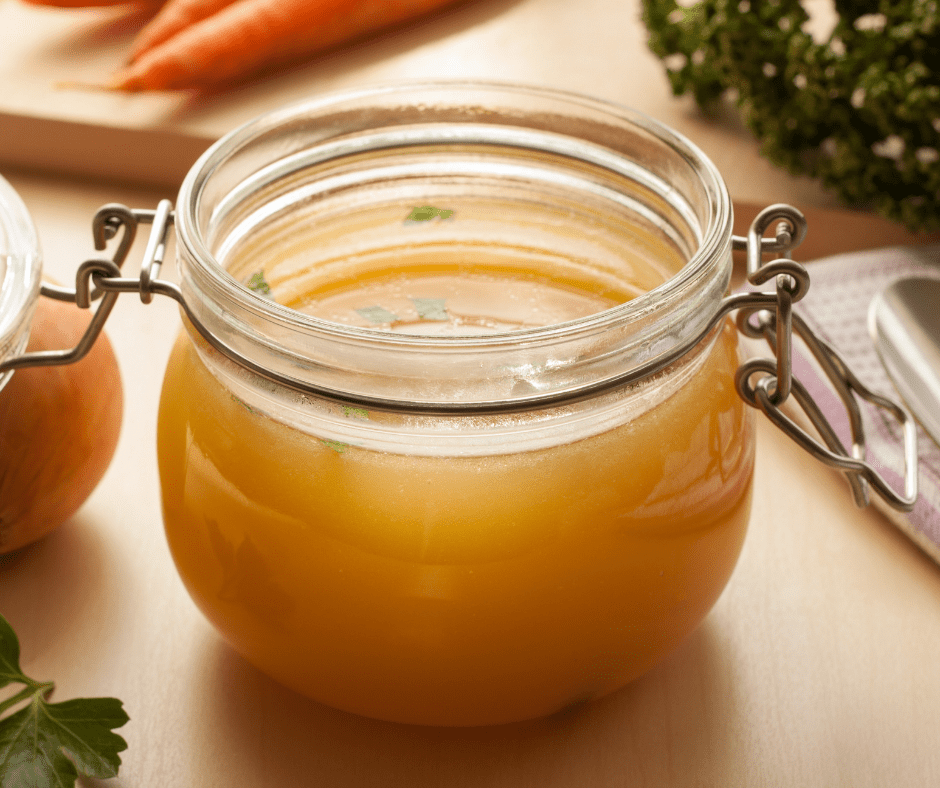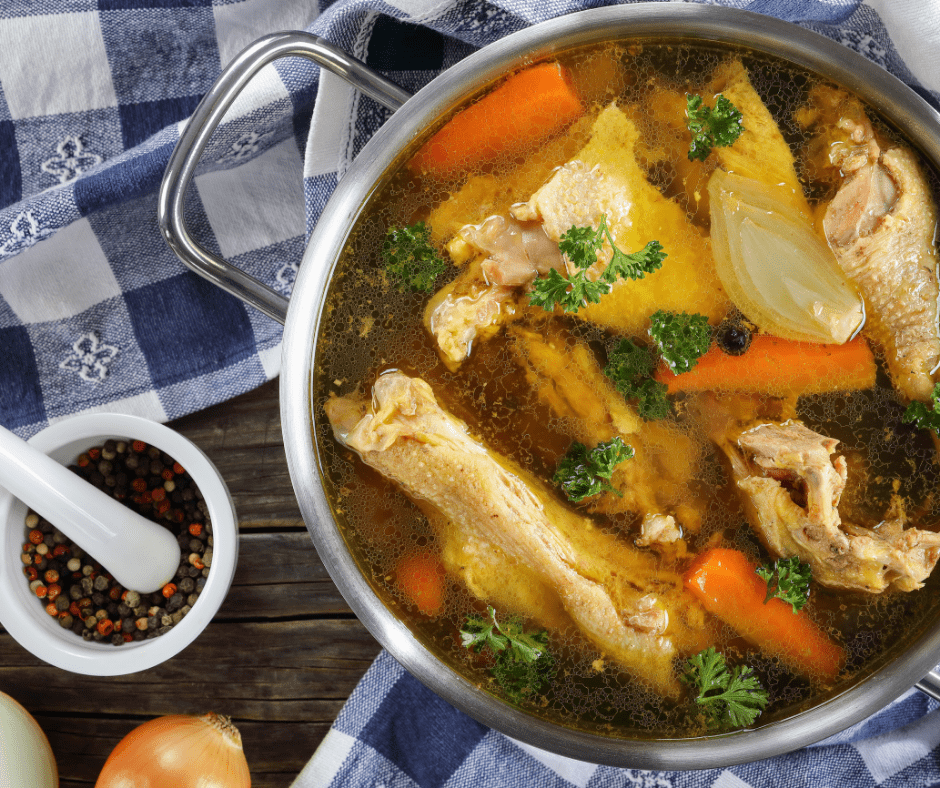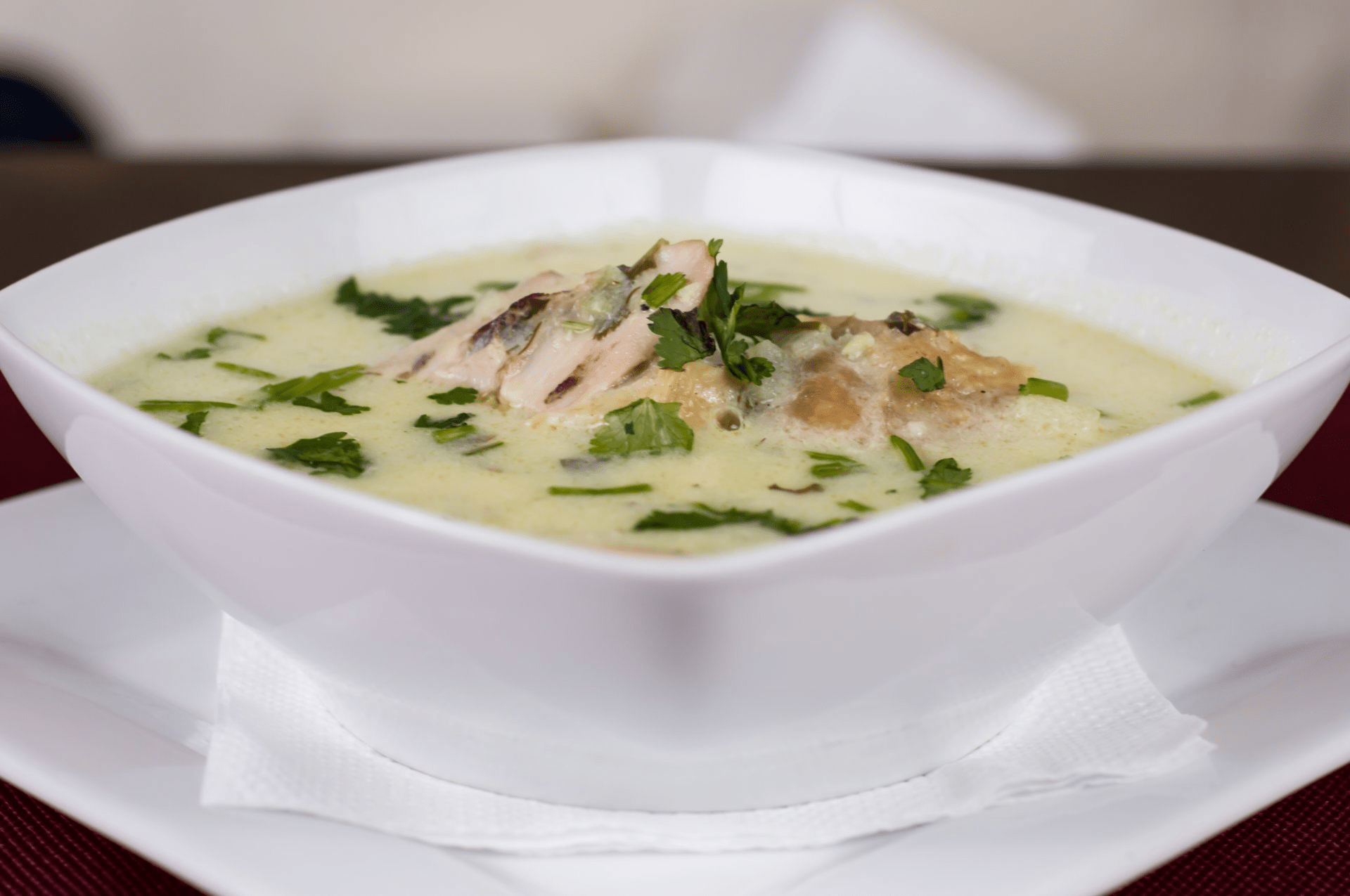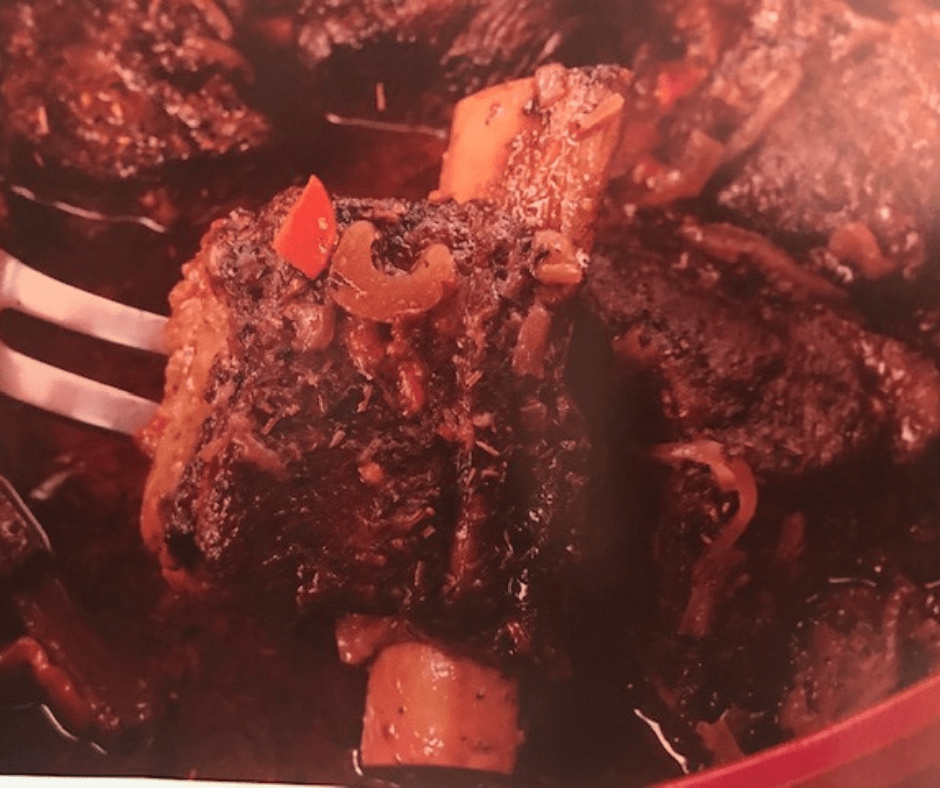You can easily make your own nutrient dense bone broth from the bones of beef, bison, fish, lamb, poultry (chicken, duck, goose, turkey) or venison. To avoid toxins, choose bones from animals that are organic, pastured, grass-fed and wild caught. Bones that contain cartilage are an excellent choice. They will produce a nutrient rich gelatin. I also recommend adding bones that include visible meat to enrich the flavor of your broth. The vegetables and spices are added both for flavor and added nutrients. Below you will read everything you need to know about making bone broth at home.
 Here are several places to find bones for your stock:
Here are several places to find bones for your stock:
- Keep all of your leftover bones from roasted chicken, a bone in roast, etc.. I store mine in a freezer bag in the freezer.
- Find a local butcher that processes the whole animal. If they do not carry the bones, they may be able to order them for you.
- Purchase bones from farmers who raise grass fed animals. Check out EatWild http://www.eatwild.com/products/index.html
- Ask your hunting friends to save bones for you during hunting season and store them in your freezer.
- Check with your grocer. Whole Foods sells soup bones
- Order online- U.S. Wellness or Tropical Traditions are good options
https://grasslandbeef.com/bones
https://healthytraditions.com/catalogsearch/result/?q=bones
Types of bones that work best:
Beef – Choose marrow rich bones like knuckles, joints, neck and feet. For flavor, add meaty bones like oxtail, shank, and short ribs.
Pork – Pig’s foot can be added to any broth recipe and it will not affect the flavor.
Poultry – Use the full carcass of the bird including necks, backs and feetAdd extra wings and thighs to chicken or turkey bone broth.
Wild Game – Avoid using the spine. Deer, moose, elk and antelope work well.
Fish – Only cook fish broth for one hour to avoid a fishy taste. Cooking longer can cause the oils to become rancid. Fishmongers will often save fish bones for you for free. Use carcasses from non-oily fish such as cod, haddock, hake, sole and snapper. Avoid carcasses of oily fish such as salmon, tuna, herring and swordfish. Tip: Chop all of your veggies more finely than with other bone broths so that the flavor will release better in the shortened cook time

Simple Bone Broth Recipe
Equipment
- Stove Top
- Slow Cooker
- Pressure Cooker
Ingredients
- 4 lbs bones choose the healthiest possible from beef, bison, venison, lamb, chicken or fish.
- 16 cups 1 gallon filtered water
- 2 Tbsp apple cider vinegar
- 2 onions quartered
- 4 carrots cut into 2-3 inch pieces
- 6 stalks of celery cut into 2-3 inch pieces
- 1 bunch parsley rough chop
- 2 bay leaves
- 1 Tbsp salt
- 2 Tbsp black peppercorns optional
- 2 cloves garlic
- herbs and spices if desired thyme, cayenne, rosemary, sage, etc.
Instructions
- Preheat oven to 400°F.
- Place bones on a roasting pan and roast for 30 minutes until browned. This will bring the flavor out.
- Place the bones in a stock pot or dutch oven (minimum 6 quart). Alternatively, you can use a slow cooker on low heat for 24 hours. You can also use a pressure cooker for 3 hours.
- Add remaining ingredients If using the stovetop method, bring the broth to a boil. Once the broth begins a vigorous boil, reduce the heat to a simmer and cover with a lid.
- Simmer for 10-24 hours. The longer you simmer, the better the broth. (Do not leave it unattended, you can stop the process and continue cooking later if necessary).
- During the simmering process, check occasionally to ensure you have enough water. Add more if necessary to keep bones covered.
- Also during the simmering process, remove the foaming impurities that float to the surface and discard.
- After desired cook time, remove from heat and allow to cool completely.
- Strain the broth in a fine metal strainer to remove all of the solid matter.
- Store in the fridge for up to 5 days, or freeze up to 6 months for later use.

Chicken Wing Bone Broth
Equipment
- Stove Top
- Slow Cooker
Ingredients
- 6 lbs chicken wings
- 2 large yellow onions chopped
- 4 stalks celery chopped
- 2 leeks chopped
- 2 heads garlic halved horizontally
- 4 carrots chopped
- 2 Tbsp black peppercorns
- ½ bunch parsley rough chopped
- 3 bay leaves
- Salt to taste
- 12 cups cold water
Instructions
- Preheat oven to 400°F.
- Place chicken on rimmed baking sheets in a single layer. Roast until deeply browned and caramelized, about 45-60 minutes.
- Remove baking sheets from oven and immediately pour 1/2 cup water onto each sheet. Tip water and bones into a large, tall soup pot, scraping off any bits still stuck to the sheets.
- Top with remaining ingredients and cover with cold water (at least 12 cups). Bring to a boil, then reduce heat and simmer, pushing down any exposed items at least 8 hours and up to 15 hours. If using a slow cooker, heat on high until bubbling, then reduce heat to low and cook 8-15 hours.
- Remove from heat and let cool 10 minutes. Strain through a fine mesh or metal strainer into a large measuring cup or lidded bowl and stir in salt to taste.
- Let sit until fat rises to the top, then skim and discard fat. Or, for easier removal, chill completely and spoon off and discard solidified fat.

Creamy Chicken "Rice" Soup
Ingredients
- 6 cups chicken broth
- 1 13.5 oz can coconut milk
- 2 cups cooked chicken shredded
- 1-2 Tbsp olive oil
- 2 cloves garlic minced
- 1 Tbsp ginger julienned
- Salt and black pepper to taste
- 2 cups cauliflower rice
- 2 green onions chopped
- 4-5 sprigs fresh cilantro chopped
Instructions
- In a soup pot, bring the chicken broth to a slow boil over medium heat. Add chicken and coconut milk and boil 10-12 minutes.
- Meanwhile, add the oil to a skillet over high heat. When the oil starts to smoke, add the garlic and saute until golden brown and crispy, 1-2 minutes.
- Stir the oil and garlic into the soup. Add the ginger. Taste and season with salt and pepper.
- Heat the cauliflower rice on the stovetop or in the microwave until just heated through.
- Evenly divide the cauliflower among serving bowls. Top with soup. Garnish with green onions and cilantro.
Notes
- If you like a heartier soup, add chopped celery, carrots and onion to instruction 1 and allow to boil until vegetables are tender.
- If you prefer a brothy soup over a creamy soup, simply omit the coconut milk.

40-Minute Short Ribs
Equipment
- Pressure Cooker
Ingredients
- 8 short ribs trimmed
- 2 cups beef broth or stock
- 4 carrots peeled and diced
- 1 medium onion peeled and diced
- 2 stalks celery diced
- 3 cloves garlic peeled and minced
- 2 Tbsp tomato paste
- 2 Tbsp olive oil
- Sea salt and ground black pepper to taste
- 1 sprig thyme
- 1 sprig rosemary
- 1 bay leaf
Instructions
- Season the short ribs with salt and pepper. Pour the olive oil into the inner pot of your pressure cooker and turn the dial to 40 minutes. Place the ribs into the inner pot and brown on all sides.
- Remove the ribs and keep aside. Add the vegetables and garlic and saute for 4 minutes. Add the tomato paste and combine to coat vegetables.
- Place the ribs back in the pot with the rest of the ingredients.
- Once the timer reaches 0, the pressure cooker will automatically switch to warm. Switch the pressure release valve to open. When the steam is completely released, remove the lid and serve hot.
Want free anti-inflammatory recipes, downloadable resources and efficiency tips and tricks from a professional chef? Of course you do! Click here for the secret sauce!







